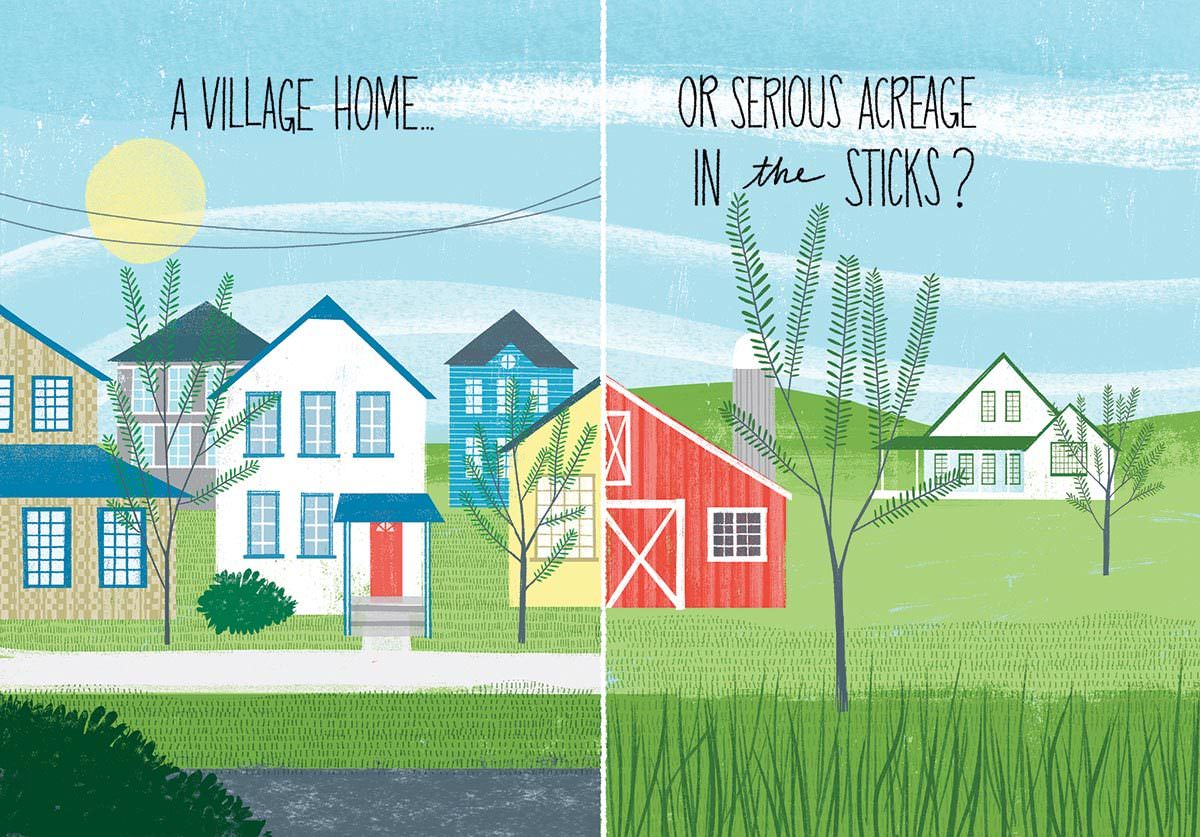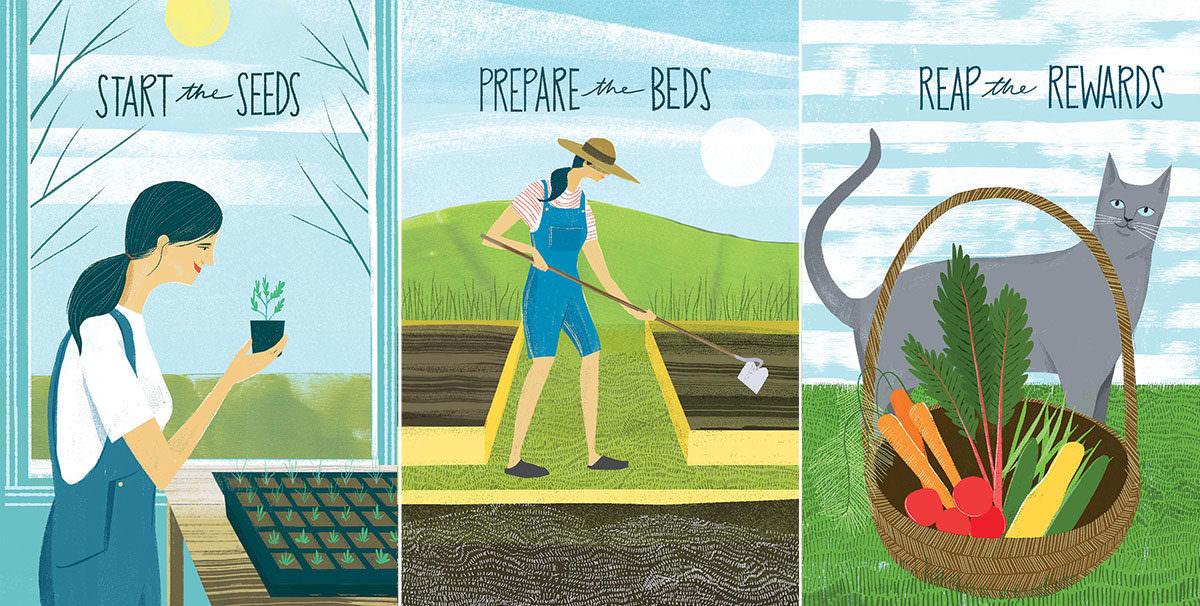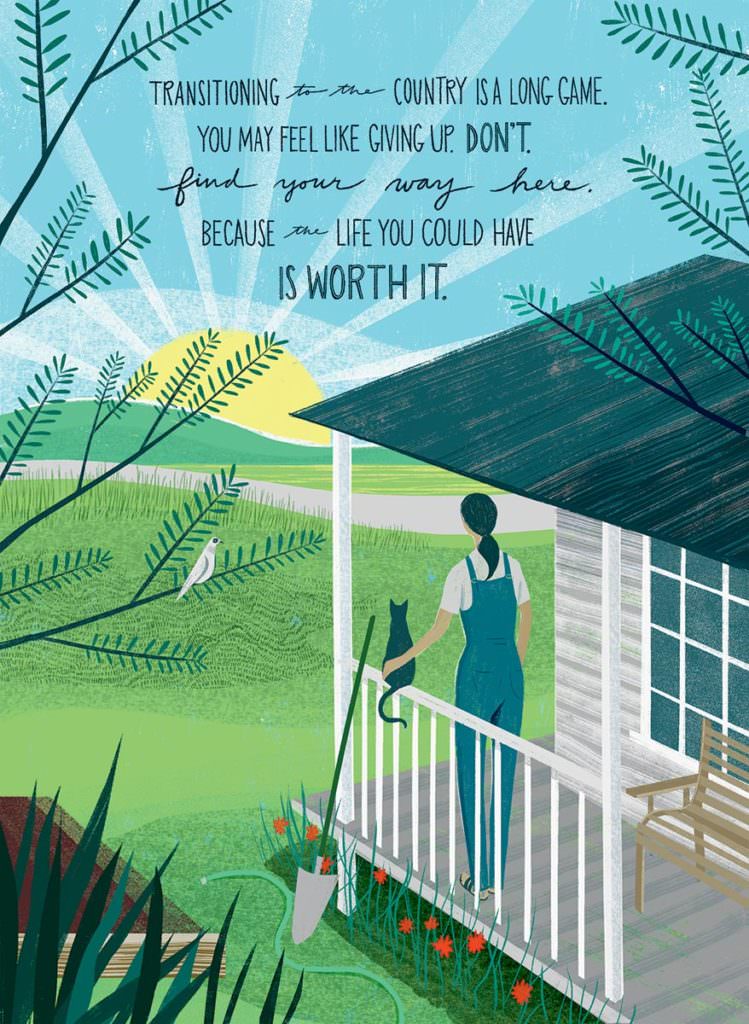How to quit the city and master the not-so-simple life, from growing your own food to gaining community acceptance.

I didn’t wave at folks driving by, a gesture I now recognize as imperative. I wore ridiculous clothes. Ridiculous. Ballet flats in the snow and a bikini in the vegetable garden. I yearned to find people like me, and began scouring the internet for other recent urban transplants, but the search results seemed overly idyllic: Couple moves to country. Couple buys chickens and goats. Couple grows amazing vegetables. Couple lives happily ever after. (Those spreads in Martha Stewart Living and Country Living magazines are staged, primped, and primed.)
Meanwhile, I’d adopted my future husband’s uncle’s gray Fila sweatpants from the ’90s – with deep pockets perfect for squirreling away snacks – as a sort of uniform. Though my dental hygiene remained steady, I went long stints between showers, gained 10 pounds, and became utterly depressed. I kept a “Skype blazer” on the back of my chair for impromptu business calls.
Eventually, I built the resource I’d been looking for: UrbanExodus.com, a site that features warts-and-all stories from others who have sought out greener pastures. Today, I can’t imagine living any other way. I’ve learned to work hard, complain little, and always lend neighbors a hand. I’ve become a chainsawing, vegetable-growing, small business”“owning country person.
I can see the stars shine bright at night and hear the birds singing and the coyotes howling. You will, too. Come join us.
[mf_h2 align=”left” transform=”uppercase”]STEP 1: Determine the ideal destination.[/mf_h2]
Just because you spent a lovely June weekend in a small town doesn’t mean that it’s the small town for you, or that you’ll enjoy living there the rest of the year. In many popular summer destinations, businesses close come winter. Are you prepared to have only a handful of stores and restaurants open? Depressing Soviet-era root vegetables in the produce aisle? Some rural communities lose power during extreme weather, leaving residents who don’t own a generator without electricity, heat, and running water. And you’ll be on the hook for plowing and shoveling your own driveway and sidewalk.
Have you considered the distance to the nearest post office, hospital, and veterinary clinic? How about the proximity of service providers? I’ve stopped counting how many times our dog has encountered a porcupine and we’ve had to drive 45 minutes to the closest 24-hour vet. I learned the hard way that a lone ob-gyn in our area was accepting new patients. And my husband and I once waited six months to get our dryer fixed, because the sole appliance repairman within a 200-mile radius was completely booked.
Then there’s the not insignificant matter of earning a living. Many people who plan to hold on to some semblance of their city career, by telecommuting or working part-time, fail to factor in the importance of reliable Wi-Fi and easy access to train stations, bus depots, and airports.
The good news: Once you’ve accepted the fact that shops close early, that food delivery and museums might be nonexistent, and that you’ll drive more than you ever have before, there are steps you can take to ensure success.
First, research your dream location from your current city home. Cruise Facebook pages and newspaper websites for towns that interest you. Search police blotters for insight on crime rates, and case job boards for employment opportunities. Google zoning laws and building codes, as well as hospital and doctor reviews. If you have children, or might have children one day, you’ll want to check out the local school ratings, homeschooling laws, and available youth programs, such as summer camps and music lessons. If you plan to raise produce or livestock and sell food products, familiarize yourself with specific state regulations, in addition to those mandated by the USDA and FDA.

CYBER-STALK YOUR DREAM LOCALE.
Thanks to Google and Facebook, you can learn a lot about a town before actually moving there. I’ve also found the following websites helpful:
City-data.com provides detailed profiles for every U.S. city, including median household income, home value, and age, as well as unemployment rates.
Farmtoconsumer.org offers accurate information about regulations on the sale of farm products – and legal advice should you get in trouble down the road.
Nraila.org breaks down gun laws by state.
Responsiblehomeschooling.org reviews state laws regarding homeschooling.
Walkscore.com rates walkability, public-transit options, and bicycling ease by zip code, neighborhood, or city.
Next, be smart about what you can afford. Many cool weekend towns cater to wealthy second-home owners and have high costs of living compared to the local median household income. You can find the median HHI online, but the best way to gauge the cost of living is to visit area supermarkets, building stores, and restaurants. And don’t be fooled by mortgage-payment calculators that spit out numbers far below what you pay in the city. Things like water, sewage, garbage removal, and oil heat – often included in apartment dwellers’ rent or HOA fees – will be your financial responsibility. The price of heating a big old house in winter can be jaw-dropping. Yearly property taxes can increase over time. Home insurance varies depending on myriad factors: the risk of natural disasters such as floods and hurricanes; distance from a fire department; the house’s age; and the number of woodstoves and replaces.
You’ll also want to be honest with yourself regarding how rural is too rural. While serious acreage and charming outbuildings can be very enticing to city people, remote locations may require you to take garbage to the dump yourself, to maintain a well for water and a septic system for sewage, even to tackle your own road repairs. A house inside the village grants entrée to the town’s water and sewage systems, snowplows, and trash pickup, albeit for a fee. In-town properties are much easier to sell and more likely to be on the same power grid as a hospital, meaning outages are rare and brief. One caveat: If you want to raise animals, local laws may forbid it or require a certain lot size.
Most of the transplants I’ve interviewed say their biggest mistake was jumping in and buying a place instead of renting first. The rental doesn’t have to be everything you’ve ever dreamed of; it just has to be livable for a year while you test-drive this new life.
PS: This might seem frivolous, but you should know that some services are more expensive in the country than in the city. You will never find a $15 pedicure in a rural location.
[mf_h2 align=”left” transform=”uppercase”]STEP 2: Shed your “citiot” skin and become a true “townie.”[/mf_h2]
Once you’ve found a home to rent or buy, it may feel like your journey has ended. Alas, this is when the real work begins. If you thought you moved out of the city to get away from people, you’ll be disappointed to learn that rural survival depends on the relationships you build within your new community.
The loss of anonymity initially freaked me out. You might discover that people already know of you, even though you’ve never met. They might drop by without calling first. And they might make assumptions about the new standoffish urbanites, so it’s important to be proactive.
Offering your services is the best way to gain friends and allies. Do you have an elderly neighbor whose lawn is overgrown? Offer to mow it. Do you have neighbors heading out of town? Offer to feed thein air animals while they’re away. Sure, you’ll encounter folks who take more than they give, but there are many things you can glean from someone who grew up in the area, has expertise working the land, or owns tools you may need to borrow. We have friends who trade goat milk for pork, and others who go in on poultry-hatchling orders to meet the minimum number of chicks.
Be a joiner. Volunteer to make cookies for the local bake sale. Attend a gallery show, reading, or other performance. In the city, it’s easy to do only what interests you. In the country, you can’t surround yourself with clones (same education, same socioeconomic level, same profession). I hang with women decades older and younger. We started a recurring art night where everyone brings a craft project and a bottle of wine. Dinner parties are the country equivalent of a wild night.
If you’re moving single and hope to date, first gauge the options. Small towns with universities or tourist seasons have a steadier ow of new faces. Sign up for the dating sites rural singles use: OkCupid, Match, Farmers Only, Western Match, and Tinder. You might be shocked by how excited neighbors will be to brainstorm good matches for you – we can’t help ourselves. But don’t steal your mate from another; nothing rocks a small town like infidelity.
Although I have fewer friends in rural Maine than I had in Seattle, my social life is much richer. Living in a community where everyone knows everyone requires all of us to be on our best behavior. There’s tremendous merit in having to swallow your pride and face problems head-on instead of avoiding them.
[mf_h2 align=”left” transform=”uppercase”]STEP 3: Grow your own food[/mf_h2]
Before going rural, I, like many Americans, paid very little attention to where my food came from – a disconnect that was neither healthy nor wise. When you plant, tend, and harvest your own crops, you know exactly what you’re eating. The process feels primordial and rewarding. It’s also humbling. Even people who have been farming for decades will tell you there’s always something new to learn. Practice may make your garden better, but never perfect.
My suggestion is to start small, with just a handful of your favorite crops, in a location that offers room to expand and receives at least eight hours of sunlight daily. Test the soil’s drainage yourself, and send a sample to a nearby lab (at a state university or a private testing facility), which can advise you on how to amend the stuff for optimal health.
For my quarter-acre garden in Maine (Zone 4), I begin growing seeds indoors around late February or early March and plant the seedlings out in late May or early June. In terms of the time commitment required, I spend a couple hours a week tending those seedling trays and roughly 15 to 20 hours prepping my raised beds in late spring. Throughout the growing season, I devote another five to eight hours a week to planting, watering, pruning, and weeding.
There are hard costs, too, though the majority involve initial investments in seed-starting supplies, soil testing, tools, irrigation systems, and infrastructure like raised beds and fencing. After that, the recurring expenses are minimal. My garden only sets me back about $75 per year now, primarily for seeds and natural soil amendments and pest deterrents.
Choosing what to grow is one of my favorite parts. Other than fruit and nut trees, most edibles need to be planted every year as annuals, but there are perennial exceptions: berries (raspberries, strawberries, blueberries), herbs (chives, lavender, rosemary, sage, thyme, tarragon, marjoram, lemon balm), and a few vegetables (rhubarb, watercress, asparagus to Zone 6, artichokes to Zone 7).
When laying out your garden, consider companion planting: Crops can assist each other by providing structural support and shade. Some pairings are also believed to deter pests or increase nutrient uptake. Basil, for instance, may improve the flavor and growth of tomatoes, while leeks are said to repel carrot flies. Nasturtiums attract aphids and draw them away from other plants.
Last, a few fast “don’ts”: Don’t plant the same crops in the same place every year (it depletes the soil); don’t overcrowd beds (follow the seed packet’s spacing directions); and don’t over- or under-water (give plants an inch or two of water per week in 60-degree weather, adding a half-inch with every 10-degree temperature rise).
Of course, the basic advice above barely scratches the horticultural surface. There are a million things to learn and, luckily, ample resources – books and websites – that go into great detail about how to prune, save seeds, compost, etc.
Growing my own food has taught me some important country lessons that extend beyond the perimeter of my garden: Good things take time, you get back what you put in, being in nature is good for the soul, some things are beyond your control, and if at first you don’t succeed, try, try again.
This has been adapted from “[amazon_textlink asin=’1624143911′ text=’Ditch the City and Go Country: How to Master the Art of Rural Life from a Former City Dweller’ template=’ProductLink’ store=’modefarm-20′ marketplace=’US’ link_id=’e232fb17-9353-11e7-a57c-b738f35564e8′]” by Alissa Hessler, creator of Urban Exodus. Copyright © 2017 Alissa Hessler. Published by Page Street Publishing Co., 2017. Printed here with permission of the publisher.


